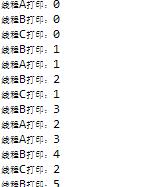Home >Java >javaTutorial >Java -- multithreading
Java -- multithreading
- 高洛峰Original
- 2016-11-21 11:09:072017browse
Multi-threading implementation method:
Inherit the Thread class
Implement the Runnable class
-------------------------------- -------------------------------------------------- ----
1. Inherit the Thread class
After inheriting the Thread class, you need to override the public void run() method of the parent class as the main method of the thread.
The execution of all threads must be concurrent, that is: multiple threads will execute alternately in the same time period. In order to achieve this goal, you must not call the run() method directly. Instead, you should call the start() method of the Thread class to start multiple threads.
Comparison of calling the start() method and calling the run() method:
public class MyThread extends Thread {
private String name;
public MyThread(String name) {
this.name = name;
}
@Override
public void run() {
for(int i=0; i<10; i++) {
System.out.println(name + "打印:" + i);
}
}
public static void main(String[] args) {
MyThread mt1 = new MyThread("线程A");
MyThread mt2 = new MyThread("线程B");
MyThread mt3 = new MyThread("线程C");
mt1.start();
mt2.start();
mt3.start();
}
}Running results: (Three threads are executed simultaneously and alternately, there is no fixed execution order)

public class MyThread extends Thread {
private String name;
public MyThread(String name) {
this.name = name;
}
@Override
public void run() {
for(int i=0; i<5; i++) {
System.out.println(name + "打印:" + i);
}
}
public static void main(String[] args) {
MyThread mt1 = new MyThread("线程A");
MyThread mt2 = new MyThread("线程B");
MyThread mt3 = new MyThread("线程C");
mt1.run();
mt2.run();
mt3.run();
}
}Running results: (Three programs Execute in sequence)

2. The principle of multi-threading implemented by the start() method
Open the start() method part of the Thread class source code:
public synchronized void start() {
if (threadStatus != 0)
throw new IllegalThreadStateException();
group.add(this);
boolean started = false;
try {
start0();
started = true;
} finally {
try {
if (!started) {
group.threadStartFailed(this);
}
} catch (Throwable ignore) {
}
}
}
private native void start0();The native keyword refers to the method of calling the operating system, start0 () method is the method of the operating system.
Since the startup of threads involves the allocation of resources in the operating system, the startup of specific threads should be implemented differently according to different operating systems. The JVM implements different implementations according to the start0() method defined in different operating systems. In this way, the name of the start0() method does not change at the multi-thread level, and different operating systems have different implementations.

Schematic diagram
Conclusion: Only the start() method of the Thread class can allocate operating system resources, so the way to start multi-threads is always the start() method of the Thread class.

